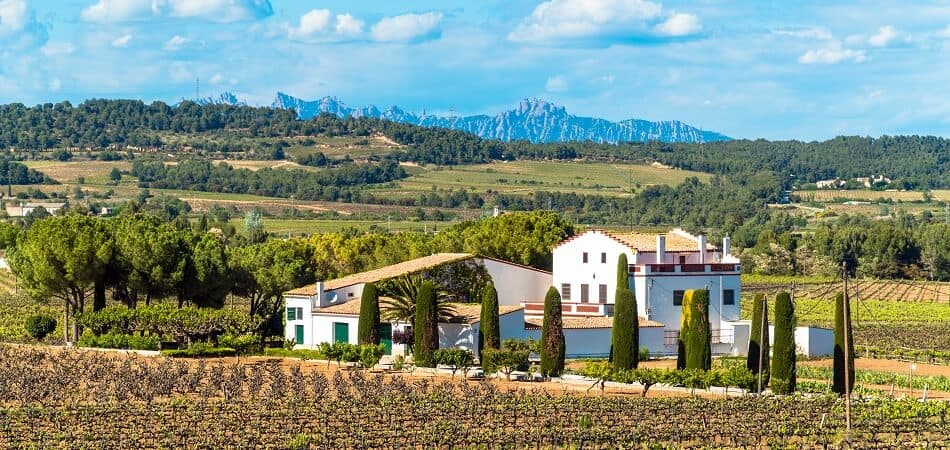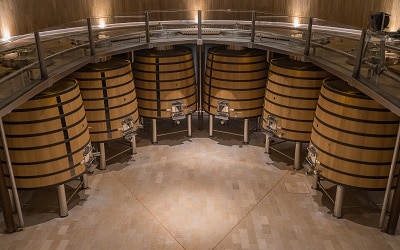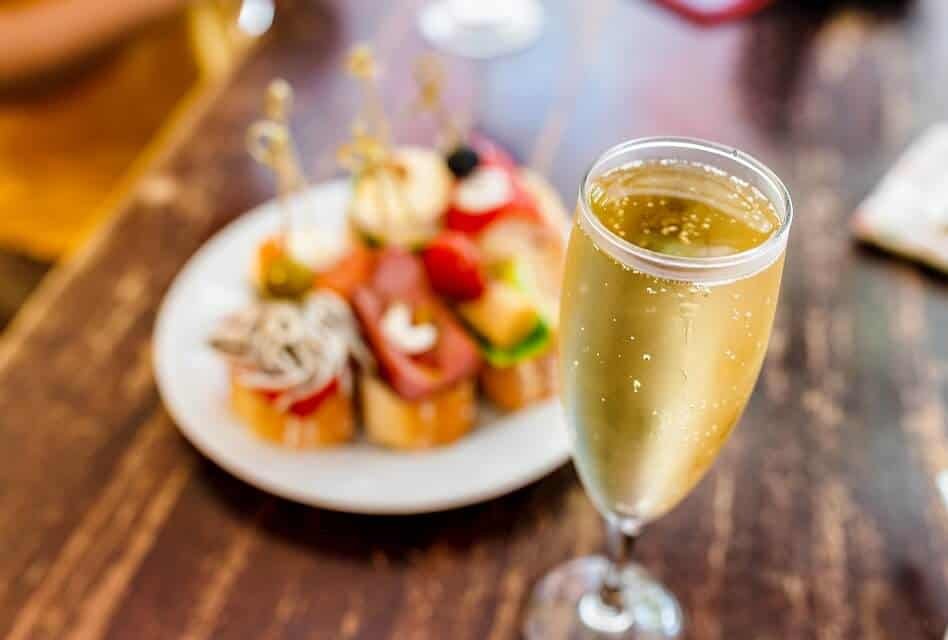Sparkling wine is wine lovers’ favorite drink to toast an anniversary, a closed business deal, or another special occasion. And you surely know excellent French sparklers such as Champagne or bubbly Italian wines like Prosecco. But have you heard of the high-quality sparkling wines from Spain? They go by the name Cava.
Cava is a high-quality sparkling wine from Spain. It is dry, light- to medium-bodied, high in acidity, and offers green fruit, citrus, and mineral aromas. It has DO status, which is the highest quality category for Spanish wine. Thus, Cava producers must follow traditional production techniques.
In the following article, we will discuss these production techniques, the different types of Cava, and how to best enjoy them.
HOW DOES CAVA DIFFER FROM OTHER SPARKLING WINES
Non-experts might confuse Cava and other sparkling wines. Do avoid falling into that trap, we will briefly discuss their differences.
Are Cava and Champagne the Same?
Cava and Champagne are two distinct types of sparkling wine. They have some similarities, though. They are both high-quality wines, they are made by following the “Traditional Method”, and their names are protected by the European Union. Thus, they can only be made in specific areas and are subject to strict production rules: Cava comes from the Northeast of Spain, while Champagne comes from the Champagne region in the northeastern part of France.
Are Cava and Prosecco the Same?
Cava and Prosecco are not the same. They are two different kinds of sparkling wine. Like Champagne, Prosecco is a protected label, and only vintners in a few communes in the Italian regions Veneto and Friuli-Venezia Giulia may produce it. But Prosecco vintners follow the “Charmat Method”, which is different from the “Traditional Method” used to produce Cava or Champagne.
Are Cava and Asti the Same?
Cava and Asti are different types of sparkling wine. Asti is a semi-sweet to sweet sparkling wine from the Piedmont region in Northern Italy. Piedmont vintners follow a unique production method called the “Asti Method” to produce it.
WHERE DOES CAVA COME FROM?
The home of Cava is Catalonia in Northeast Spain. More than 90% of the sparkling wine comes from one of its sub-regions called Penedès. The city of Sant Sadurní d’Anoia is the center of the production efforts. But some other areas belong to the Cava DO appellation as well. Among them are Aragón, Euskadi, Extremadura, La Rioja, Navarra, and Valencia.

WHAT IS CAVA MADE FROM?
Most Cava wines are blends made from multiple grape types. There are some single-varietal variations, though.
The traditional white grapes for Cava production are:
- Macabeu is a variety with a relatively neutral taste. It adds body to the wines.
- Xarel·lo is high in acidity and offers floral and earthy aromas.
- Parellada grapes feature green fruit and citrus flavors.
- Subirat grapes are very aromatic. This variety is also known as Malmsey on the island of Madeira, where vintners use it to make fortified Madeira wines.
Besides these traditional varietals, vintners may use a couple of other grapes, including Chardonnay and Pinot Noir.
The most common red varieties for making Cava rosé wines are Garnacha, Monastrell, Pinot Noir, and Trepat.
HOW CAVA IS MADE
Cava vintners follow the “Traditional Method” (or “Método Tradicional”, as the Spanish call it). This technique for making high-quality sparkling wines comes from France, where vintners developed it to make their famous Champagne wines. Thus, it is also called “Méthode Champenoise”.
This method consists of multiple production steps.

- Usually, the grape harvest takes place in August. Unlike Champagne vintners, Spanish winemakers may use machines to gather them. Nevertheless, many prefer to harvest by hand to reduce the risk of damaging the grapes.
- Next, the different varietals are pressed separately. Vintners can only use the grape juice from the first pressing.
- The first fermentation is the next stage in the production process. The wine ferments in big steel or wood tanks until all sugar is transformed into alcohol.
- After the fermentation, the vintners blend portions of the different varietal wines and clarify and stabilize the resulting wine.
- The second fermentation phase is what is unique about the Traditional Method. The winemakers bottle the blended wine and add a mix of yeast and sugar. This mix, called “tirage liqueur”, starts the second fermentation, known as “bottle fermentation”. Based on the desired style of wine, it can take between 9 and 30 months.
- The riddling follows the fermentation. The vintners turn the bottles upside down, either manually or with the help of machines. Then, they riddle the bottles, so the dead yeast cells gather in the bottleneck.
- As soon as all the dead yeasts are in the bottleneck, the vintners remove this sediment. For this purpose, they freeze the neck and open the bottle cork. The pressure inside the bottle then forces the ice plug containing the yeasts out. This process is called disgorgement.
- Next, the winemakers perform the dosage. They add wine (and, in some cases, sugar to make the wine sweeter) to compensate for the liquid lost during disgorgement.
- Finally, they seal the bottle with the final cork and add the wire cage to secure the cork.
THE DIFFERENT TYPES OF CAVA
Although Cava is subject to strict production rules, the wines can differ perceivably in taste and sweetness. The most obvious characteristic to distinguish them is their color, though:
- Most wines are white. Their appearance is similar to Champagne or Prosecco sparkling wines.
- Cava can also belong to the category of rosé sparkling wines. These are made from red grapes and go by the name Rosado.
- Red styles do not exist.
Besides the color, you can distinguish the sparkling wines by their age (or, more precisely, by the duration of the second fermentation phase):
- For regular styles, this phase is at least 9 months long.
- Reserva styles undergo the same production process, but they age for at least 18 months in the bottle.
- For Gran Reserva wines, the aging process is even longer. They ripen for 30 months or more.
Finally, Cava wines differ in sweetness. Most wines are dry, but you can also find other styles, ranging from off-dry to sweet. The bottle label tells you how much residual sugar the wine contains:
- Brut Nature: less than 3 grams of residual sugar per liter of wine
- Extra Brut: 3-6 g/L
- Brut: 6-12 g/L
- Extra-Seco: 12-17 g/L
- Seco: 17-32 g/L
- Semi-Seco: 32-50 g/L
- Dulce: more than 50g/L
HOW DOES CAVA TASTE?
The vast majority of Cava sparkling wines are dry (brut), light- to medium-bodied, and have a high level of acidity. They feature refreshing flavors of citrus and green fruits as well as mineral notes.
Reserva and Gran Reserva wines have even higher levels of acidity and also a slightly bolder body. In addition to their citrus and mineral aromas, they often develop earthy notes.
When drinking Rosado, you can typically sense red berries and floral notes.
HOW TO STORE CAVA WINES
Cava sparkling wines should be stored in a dark, cool place. Ensure to protect them from sudden temperature changes, vibrating devices such as regular fridges and air conditioning, and aggressive smells from chemicals.
Can Cava Go Off?
Like all still and sparkling wines, Cava can go bad. Especially when exposed to sunshine, heat, or oxygen, it might go off and incorporate a very unpleasant, vinegar-like smell. And, of course, it can lose its fizz if it is not sealed properly.
Thus, it is vital to protect your bottles by storing them properly.
How Long Does Cava Last When Open?
Typically, sparkling wines like Cava lose their bubbles pretty quickly after opening the bottle. Therefore, it is crucial to reseal them with bottle stoppers and put them into the fridge to keep them cool. Consume the rest within 1 to 2 days.
Can Cava Be Aged?
Some Cava wines, especially Reserva wines, can be stored for a few years. In general, you should not keep your sparkling wines too long, though. Better enjoy them soon after buying them to ensure they won’t go bad.
HOW TO SERVE CAVA
Of course, Cava is a great beverage to enjoy on its own, for instance, at a standing reception. But it is also surprisingly food-friendly, so you can enjoy it with dinner. No matter the food pairing, you should make sure to serve it at the right temperature and in the proper glassware.
What Is the Right Serving Temperature for Cava?
The optimal serving temperature for Cava is 43 to 46°F (6-8°C). Like most other sparkling wines, serving it cool preserves its freshness, including its delicate bubbles.
To chill it down, place it in the refrigerator for about 30 to 45 minutes before opening the bottle. Be aware that you should not put sparkling wines in the freezer because that can mute their bubbles and make them taste flat.
What Is the Right Glass for Cava?
Just like Champagne or Prosecco, Cava benefits from being served in a flute. These tall, slim glasses help preserve the bubbles, so the wine stays fizzy longer. Also, the long stem allows you to hold your glass without touching the bowl. Thus, your hand will not heat the wine.
Alternatively, you can use a tulip-shaped sparkling wine glass. It is similarly effective in keeping your sparkler fresh.

$64.97
from: Wine.com
Should You Decant Cava
You should not decant Cava. As soon as you open the bottle, the bubbles will slowly disappear. And the longer the wine is exposed to air, the sooner it will become flat. Decanting fastens this undesirable process. Besides, it is ready to be consumed as soon as it makes it to retail, so it doesn’t need aeration to showcase its full aroma.
CAVA FOOD PAIRING
As mentioned before, Cava is food-friendly, and you can pair it with various dishes. To find the best match, follow this simple rule of thumb: The longer the wine’s bottle fermentation phase takes, the bolder the matching meal can be.
For instance, young Cava is an excellent beverage to drink with Asian food. Dishes from Vietnamese, Indian, or Thai cuisine, which combine exotic flavors with a subtle spiciness, are just perfect with younger variations of the Spanish sparkler.
As it comes from Spain, it makes perfect sense to pair Cava with Spanish tapas. Enjoy it with Serrano ham or Jamón Iberíco, olives, dried tomatoes, or almonds. Ham specialties from other regions, such as Italian Prosciutto, are excellent pairings, too.
Another food to enjoy with Cava is seafood, especially when you open a Gran Reserva bottle. When serving smoked fish like salmon or fried meals such as fish and chips, you should consider the Spanish sparkler to accompany your meal. Shellfish is a fantastic match, too, including oysters, prawns, and gambas. Cava can even handle spicy preparations with flavors of hot chilis or garlic. Their bubbles help clean your palate after each bite and tone down the heat.
CAVA SHOPPING TIPS
Cava is a protected label, so only the original sparkling wines from Spain may carry it. So, to be sure, you do not fall for a copycat, check where the wine comes from.
Even decent styles are very affordable. Typically, entry-level wines cost around 15 USD. Here are some examples:
Freixenet Cordon Negro Cava Brut
- type: white, sparkling
- origin: Catalonia, Spain
- varietal: Macabeo, Parellada, Xarel·lo
- alcohol: 11.5%
Vins el Cep Kila Cava Brut 2018
- type: white, sparkling, Vintage
- origin: Catalonia, Spain
- varietal: Macabeo, Parellada, Xarel·lo
- alcohol: 12.0%
- type: rosé, sparkling
- origin: Catalonia, Spain
- varietal: Trepat
- alcohol: 11.5%
Reserva wines are only slightly more expensive. Expect to pay about 20 USD per bottle. Gran Reserva wines can cost up to 50 USD.
Cava Mestres Reserva Brut 1312
- type: white, sparkling
- origin: Catalonia, Spain
- varietal: Macabeo, Parellada, Xarel·lo
- alcohol: 11.8%
Avinyo Cava Reserva Brut Nature 2016
- type: white, sparkling, Vintage
- origin: Catalonia, Spain
- varietal: Macabeo, Parellada, Xarel·lo
- alcohol: 11.4%
Vins el Cep Claror Brut Nature Gran Reserva Cava 2014
- type: white, sparkling, Vintage
- origin: Catalonia, Spain
- varietal: Macabeo, Parellada, Xarel·lo
- alcohol: 12.0%
FINAL WORDS
Cava is truly a high-quality sparkling wine and a great alternative to French Champagne or Italian Prosecco. And in many cases, you can get a good bottle for little money. So for your next toast, consider serving your guests a glass of Spanish sparkling wine.
Recent Posts
Switzerland is famous not only for its beautiful landscapes and its picturesque towns but also for some food items. Especially Swiss cheese and chocolate are world-famous. But do you actually know a...
Winemaking is a sophisticated process that includes multiple steps and can take several years. Depending on the desired wine and the vintner's preferred techniques, these steps can differ. However,...

